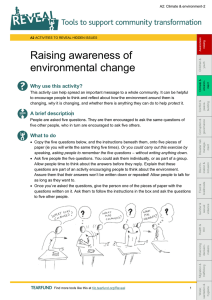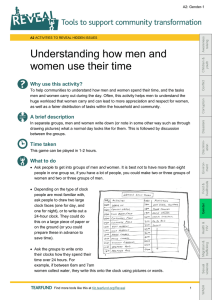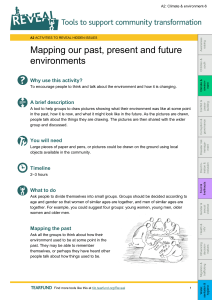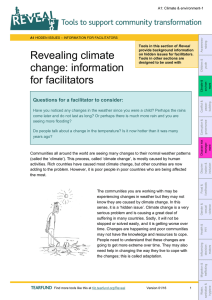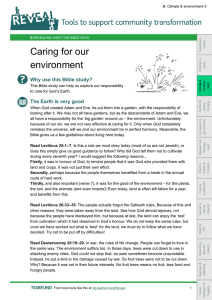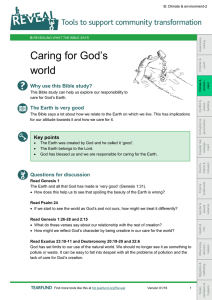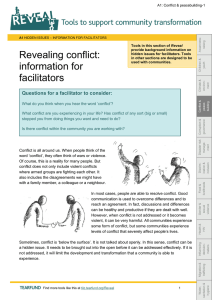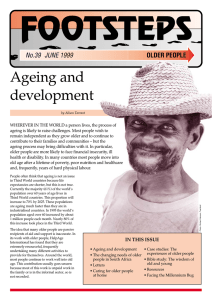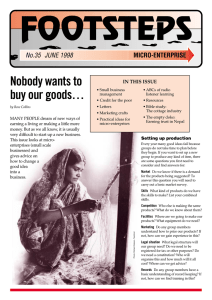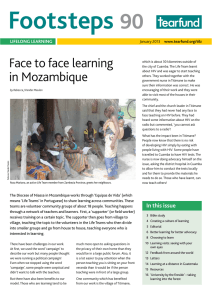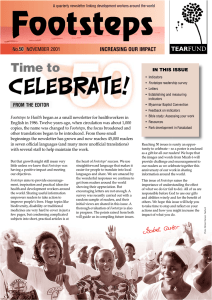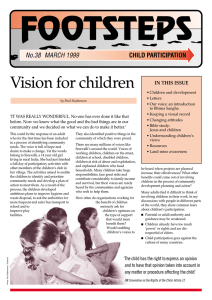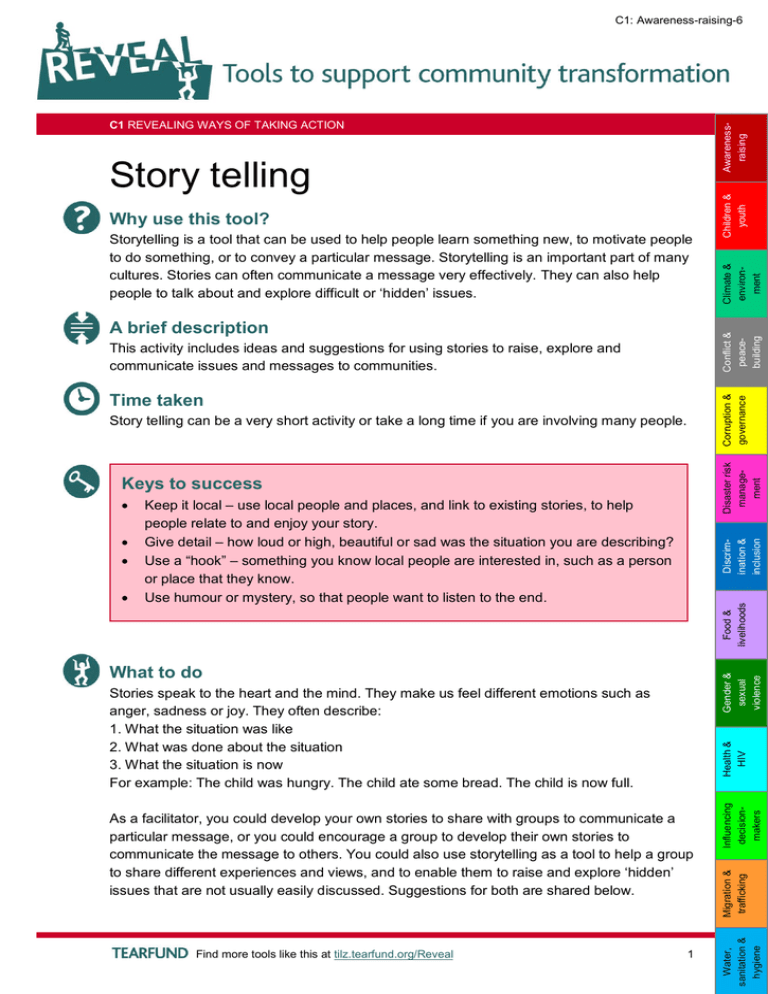
C1: Awareness-raising-6
Why use this tool?
Storytelling is a tool that can be used to help people learn something new, to motivate people
to do something, or to convey a particular message. Storytelling is an important part of many
cultures. Stories can often communicate a message very effectively. They can also help
people to talk about and explore difficult or ‘hidden’ issues.
Conflict &
peacebuilding
A brief description
Corruption &
governance
This activity includes ideas and suggestions for using stories to raise, explore and
communicate issues and messages to communities.
Time taken
Disaster risk
management
Story telling can be a very short activity or take a long time if you are involving many people.
Keys to success
Discrimination &
inclusion
Food &
livelihoods
Gender &
sexual
violence
What to do
Health &
HIV
Stories speak to the heart and the mind. They make us feel different emotions such as
anger, sadness or joy. They often describe:
1. What the situation was like
2. What was done about the situation
3. What the situation is now
For example: The child was hungry. The child ate some bread. The child is now full.
As a facilitator, you could develop your own stories to share with groups to communicate a
particular message, or you could encourage a group to develop their own stories to
communicate the message to others. You could also use storytelling as a tool to help a group
to share different experiences and views, and to enable them to raise and explore ‘hidden’
issues that are not usually easily discussed. Suggestions for both are shared below.
Find more tools like this at tilz.tearfund.org/Reveal
1
Influencing
decisionmakers
Migration &
trafficking
Keep it local – use local people and places, and link to existing stories, to help
people relate to and enjoy your story.
Give detail – how loud or high, beautiful or sad was the situation you are describing?
Use a “hook” – something you know local people are interested in, such as a person
or place that they know.
Use humour or mystery, so that people want to listen to the end.
Water,
sanitation &
hygiene
Climate &
environment
Story telling
Children &
youth
Awarenessraising
C1 REVEALING WAYS OF TAKING ACTION
C1: Awareness-raising-6
C1 STORY TELLING
Using stories to communicate a message
Awarenessraising
You could share a story with a group, and then ask them questions about the story. Here are
a few examples:
Example 1
Children &
youth
Climate &
environment
Two women were walking through their
village when one asked the other to help
her clear away some of the plastic bags
which had got stuck in the thorn bushes.
The second woman couldn’t understand
why they should do that when they
hadn’t put the bags there.
Conflict &
peacebuilding
Several days later, this second lady’s goat died when it ate a plastic bag. From then on,
the second woman helped the first woman to clear away the plastic bags from their
village and encouraged other people to do the same.
Corruption &
governance
Discussion questions:
What principle is illustrated by this story?
What more could we do to protect the environment in our community?
Disaster risk
management
Example 2
Discrimination &
inclusion
In an informal urban settlement, there was a
mystery! Seven children, from three families, got
diarrhoea. One week later, another few children
also became ill. What did all they have in
common?
Food &
livelihoods
They all went to the same school and ate school
lunches. Maybe this was the cause?
Gender &
sexual
violence
Some of the parents went to visit the school principal and, together, they all went to the
kitchen. As they walked through the door, two cockroaches hopped out from a crack in
the floor. ‘Is this normal?’ the head teacher asked the cook, pointing at the cockroaches.
‘Yes it is,’ replied the cook.
Health &
HIV
Influencing
decisionmakers
They had found the most likely reason for the children becoming unwell: the kitchen was
unclean and the cockroaches were infesting it and contaminating the food. The head
teacher asked the school maintenance man to kill the cockroaches by using a safe
insecticide. Afterwards, the children stopped getting diarrhoea.
Migration &
trafficking
Discussion questions:
What is the moral of this story?
What can we do to prevent children getting ill?
Water,
sanitation &
hygiene
Find more tools like this at tilz.tearfund.org/Reveal
2
C1: Awareness-raising-6
C1 STORY TELLING
Children &
youth
Awarenessraising
You could also ask the group themselves to develop stories to communicate a particular
message. You could ask them to consider what the most important messages are for their
community. For example, if the community has chosen to focus on improving health, the
messages could include hand washing, covering food or using a latrine. Effective messages
should be short, positive and easy to adapt. You could also encourage the group to develop
simple role-plays or songs to communicate messages.
Using stories to help raise and explore hidden issues
Disaster risk
management
Corruption &
governance
Conflict &
peacebuilding
Climate &
environment
Stories can help people to talk about sensitive issues that they would otherwise find difficult,
or about other issues that they wouldn’t normally think about discussing. There are many
ways in which stories can be told: they can be spoken or acted. Stories can be told using
role-plays or puppets or interviews or drawings or video / film or radio. People can often act
out difficult situations without feeling embarrassed. Role plays or puppets can also help
people to laugh and relax. It is important
to remember that sharing stories about
difficult issues requires trust and
openness. And some people may not
want to share any stories. This is to be
respected and people should never be
forced to share anything or made to feel
embarrassed if they don’t take part.
Developing stories
Discrimination &
inclusion
There are many ways of encouraging a group to share and develop stories. Here are a few
suggestions:
Influencing
decisionmakers
2. Another simple approach might be to ask people to talk about what they see – the sights,
smells and sounds in their communities – and to share how they would describe their
community to a stranger. You could ask them to describe what they feel when they see
things in their community: what makes them happy, and what makes them sad or fearful.
3
Water,
sanitation &
hygiene
Migration &
trafficking
3. The following activity could also be used to help a group make up a story. (This is taken
from Footsteps 58 – Using theatre in development. See ‘Finding out more’, below.)
o Divide participants into two groups and form two circles – an inner and an outer,
with each inner participant facing one outer participant.
Find more tools like this at tilz.tearfund.org/Reveal
Health &
HIV
Gender &
sexual
violence
Food &
livelihoods
1. Ask people to tell each other stories in pairs.
Ask them to identify something amusing,
thought-provoking or interesting. Then the
listener can retell to another person the
story they just heard. Or participants could
pass one story round a circle, with each
person making slight changes each time the
story is retold.
C1: Awareness-raising-6
C1 STORY TELLING
o
Awarenessraising
o
Children &
youth
o
Climate &
environment
o
Conflict &
peacebuilding
o
Corruption &
governance
Ask the inner circle to begin a story. It helps to provide them with a suggestion.
For example, ‘Tell a story about a secret box.’ Each person then makes up a story
and tells it to their outer circle partner for exactly one minute.
Ask the outer circle to move round one place and then pass on the story they
have just heard to their new inner circle partners. This time, however, they must
include something new in the story – for example, ‘a leopard’.
Again, time the storytelling for exactly one minute. (Suggest words to stimulate
thinking about specific topics such as bullying, violence and gender but you
may need to be sensitive to other people’s privacy because some stories may
bring up pain and may be difficult to share. However, it is important to add funny
or silly ideas too, to ensure a feeling of fun or light-heartedness.)
Ask the outer circle to move round one place again to the next inner circle person,
who will repeat to them the story they have just heard – again including ‘a secret
box’ and ‘a leopard’ and one more new idea.
Continue this process of moving the outer participants on one place each time.
Participants will alternately listen to a story and then pass it on to another person
– always adding one new idea. Stop when all outer participants have partnered
with all inner circle participants. Stories will become very muddled and confused,
but this is all part of the fun!
Disaster risk
management
Discrimination &
inclusion
Food &
livelihoods
Gender &
sexual
violence
By the end of the exercise, each person
will have a unique final story which
includes input from each participant. Now
divide the participants into several small
groups. Ask each of them to tell their final
stories to each other and decide which
story they prefer. These stories can then
be told to the other groups. Decisions
about what is included in the stories will
reveal a great deal about the group as a
whole – how they feel, what they think
and believe, and how they relate to others
in the community.
Finding out more
Health &
HIV
Influencing
decisionmakers
Tearfund (2004) Footsteps 58 – Using theatre for development
http://tilz.tearfund.org/en/resources/publications/footsteps/footsteps_51-60/footsteps_58/
Tearfund (2012) Footsteps 87 – Non-communicable diseases - article on ‘Creative ways of communicating
health messages’ http://tilz.tearfund.org/en/resources/publications/footsteps/footsteps_8190/footsteps_87/creative_ways_of_communicating_health_messages/
Tearfund (1995) Footsteps 23 – Drug Rehabilitation – article on ‘Puppets’
http://tilz.tearfund.org/en/resources/publications/footsteps/footsteps_21-30/footsteps_23/puppets/
Migration &
trafficking
Related tools:
C1 – How to write a community drama [C1: Awareness-raising-7]
Water,
sanitation &
hygiene
Find more tools like this at tilz.tearfund.org/Reveal
4


